The new Canada’s food guide is the first that puts the science of healthy eating squarely before politics. Here’s what’s new in the Canadian food guide.
The new Canada’s food guide has generated a lot of buzz. Much of the buzz has focused on reducing the four food groups to three, replacing the “Milk and Alternatives” and “Meat and Alternatives” food groups with “protein foods”.
What is Canada’s food guide? It is a guide that everybody, young and old, can use to ensure they are eating a reasonably healthy plate of food. These are healthy eating guidelines, but the details are up to you. TIn essense, it answers the question: “How can I eat healthy everyday?”
he Canadian food guide has been revamped for 2019.
The evolution of the food guide can be seen in these images of the covers. Below are previous guides from 1942, 1949, 1977 (the food guide I grew up with) and 1997. As you can see, the notion of a balanced diet has evolved over time
Another major focus has been on removing food guide servings or portions. Dr. Hasan Hutchinson, director general the Office of Nutrition Policy and Promotion at Health Canada says, “It’s not about portion per se, but perhaps about proportion,” now. That makes the Canadian food guide a bit more like the concept of the “food pyramid”, as is found in the American food guide.
Eating well with Canada’s food guide?
Most of the changes are science-based. One of the best known secrets in Canada (and in the USA food guide, too!), is how the dairy and beef industries have been able to twist the official food guide in their favor for decades, at the expense of sound nutritional advice. As a result, many Canadians simply ignored the guide, figuring that it was not a credible document.
No more! Canada’s food guide is now based squarely on science. It represents the best understanding of nutrition that we have today. At last, we have a “nutrition food guide” or a “healthy eating guide”, not just a political compromise.
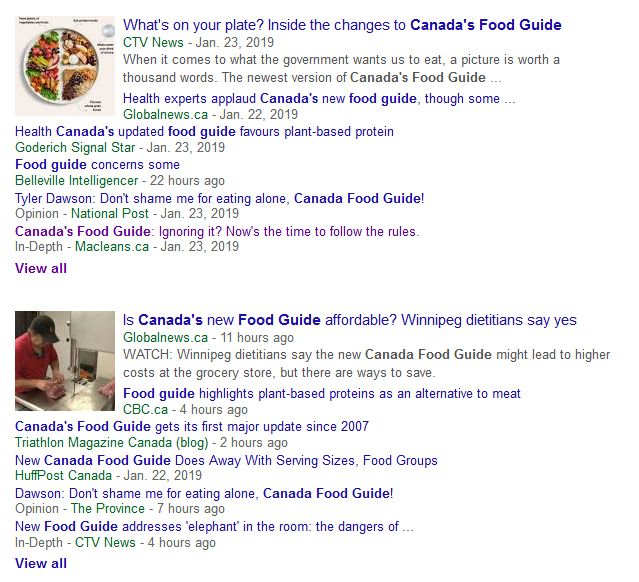
What are the new Canada’s food guide recommendations for 2019
There are new recommendations in the Canada’s food guide. Some old recommendations have been removed. Others have been changed. Let’s look quickly at each change.
Eat more plants
“Eating plant-based foods regularly can mean eating more fibre and less saturated fat. This can have a positive effect on health…”
My vegetarian friends will surely be pleased that they no longer have to eat their fellow Earthlings.
But note that the guide doesn’t say not to eat animals or animal products. The cover, which shows the three new groups, features an egg, some yogurt, and what looks like some beef, chicken and fish. But these form about half of the protein food group. There also three types of nuts, three types of pulses (legumes), tofu and some seeds. Now, that’s healthy food!
I wrote earlier why removing the dairy food group is a good thing.
Having condensed “Milk and Alternatives” and “Meat and Alternatives” into a single group, the guide explains that the “plenty of vegetables and fruits” group should form half of our diets. The cover features a healthy plate with ideal proportions, just in case some people find this concept challenging.
Make no mistake, this is the central message of the new Canada’s food guide:
“Many of the well-studied healthy eating patterns include mostly plant-based foods.”
Interestingly, the US Food Guide Pyramid gives more weight to grains than to fruits and vegetables combined.
The cover of the new Canadian guide features nine types of vegetables, but just three types of fruit, two of which are berries. Pay attention to that message.
Eat fewer processed foods
“You should limit highly processed foods and drinks because they are not a part of a healthy eating pattern.”
Yes, yes, yes! One of my two guiding principles to eat healthy is to eat as close to nature as possible (the other is to eat as much variety as possible).
The more processed, the less nutrition a food has, and the more bad things you will find in it.
- Extra salt, fat and sugar are often found in pre-packaged foods.
- Heat destroys many nutrients, so pre-cooked or canned foods lose nutrients (the food guide doesn’t mention this).
- Processed foods often contain artificial coloring, artificial flavoring, preservatives, emulsifiers and all sort of things that are at best useless to your body, and at worst harmful (the food guide doesn’t mention this, either).
Healthy eating habits mean eating more raw food and cooking food yourself, rather than buying ready-made, processed food.
Here’s something that’s gotten no buzz at all. I’ve read a couple dozen articles on the new Canada’s food guide: and I’ve seen not even a passing mention. White bread is out. Finally! The official food guide recommendation is to eat a variety of whole grains.
“Choose whole grain foods.”
White bread, with its bleached flour, is more processed than whole grain foods. So this is 100% in keeping with the recommendation to stay away from highly processed foods.
Drink water
If you want to reduce your intake of processed foods, drinking water makes sense. It is the least processed drink. And it is what keeps us hydrated best. It’s also calorie-free, and as the guide notes, it is free of sugar and sodium.
If you think dairy is the big loser in the new food guide, consider fruit juice manufacturers. They used to be part of the recommended fruits and vegetables group.
Now the guide recommends against them, as well as other sugary drinks.
Fruit juice is processed food. It is not healthy food. It is so much better to eat the fruit, including all the pulp and skin (and sometimes, even the seeds).
There has been a lot of buzz about alcohol not being recommended. Despite the chatter, one doesn’t notice much about alcohol in the food guide. The detailed guidelines that the public will rarely see actually do make a big deal of alcohol:
“Alcoholic beverages can contribute a lot of calories to the diet with little to no nutritive value. When alcohol is mixed with syrups, sugary drinks such as soft drinks and fruit-flavoured drinks, or cream-based liquors, they can be a significant source of sodium, free sugars, or saturated fat.”
These detailed healthy eating guidelines go much further than ever before, launching pretty much a full frontal attack on alcohol:
“Further, the substantial disease burden attributed to alcohol intake is a leading global health concern. There are well-established health risks associated with long-term alcohol consumption, including increased risk of many types of cancer—liver, oesophageal, mouth, pharynx, larynx, colorectal, and breast (post-menopausal)— and other serious health conditions (such as hypertension and liver disease).”
And it recommends to the public:
“People who do not consume alcohol should not be encouraged to start drinking. If alcohol is consumed, Canada’s Low-Risk Alcohol Drinking Guidelines can be used to provide information on how to reduce the risk of alcohol-related harms in both the short and long term.”
Alas, few people will see these detailed guidelines. In the main sections of the guide, alcoholic drinks are mentioned only in passing, along with all other juices and drinks.
The fact is that alcohol is a highly processed food. Want to put barley or grapes in your body? There are much healthier ways.
Which brings me to one of my beefs about political interference. Have you ever seen a nutrition label on a bottle of beer or wine or whisky? Me neither. Every other food and drink is subject to nutritional labeling. Not alcoholic drinks. Somebody must be lobbying hard.
If people saw how many calories were in a glass of wine or how much sugar was in a bottle of beer, some people would limit their drinking, to the health and well-being of society.
Feel good about healthy eating
This is a tricky bit. The Canada’s food guide now recommends eating with others and enjoying our food.
“Enjoying healthy foods with family, friends, neighbours or co-workers is a great way to connect and add enjoyment to your life. It can provide many benefits and contribute to a healthy lifestyle.”
“Enjoying your food is part of healthy eating. Enjoy the taste of your food and the many food-related activities that go along with eating.”
What do either of these recommendations have to do with nutrition and healthy food?
I think the first recommendation is because we are less likely to gorge on stuff that’s really bad for us when we eat with others.
We are also likely to eat slower, as we chat. Eating slower means that after the first plate, we are already feeling the food in our stomachs (and less likely to crave a second helping).
I’m really not sure about this one, though. When people eat together, I find there is more likely to be alcohol flowing, as people don’t like to drink alone. There is also often pressure to eat dessert.
As for the second recommendation, to enjoy your food, I assume this means that you should use healthy ingredients to make food you will enjoy. Eating healthy doesn’t have to be celery sticks with peanut butter, for instance. Am I interpreting this right? It’s possible.
Proportions, not portions
This new food guide recommendation is less one of science as one of clarity. People trying to follow the old food guide got confused about what a portion is.
Is this big banana a portion? Or this little one?
Are these portions really right for me if I’m taller than average? Older than average? Fitter than average?
Instead, the new guide gives direction on what a healthy plate should look like in proportions:
- Half of what you eat should be fruits and vegetables.
- A quarter of what you eat should be whole grains.
- A quarter of what you eat should be protein foods.
A glance at the “healthy plate” illustration, lays out pretty clearly what the food guide servings are, even if you don’t read past the cover.
Of course, anybody who has ever taken even a tiny interest in nutrition and healthy eating already knows this. It’s certainly not news, nor has it been for decades. But it’s finally the basis of Canada’s food guide. Eating well with Canada’s food guide is not longer such a stretch.
There are lots of new recommendations in the new Canada’s food guide. If you’ve ever read about nutrition or eating a balanced diet, nothing in this edition should come as a surprise. Except that it’s finally based on science, not on industry lobbying.
Labeling on vodka, anyone?


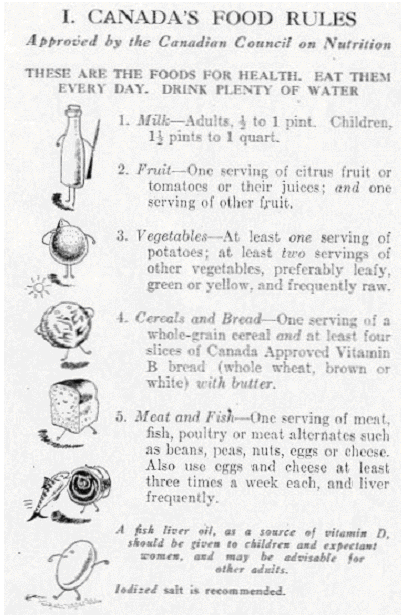
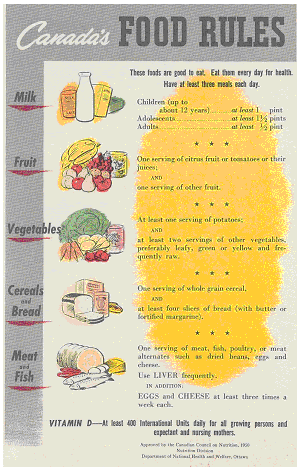
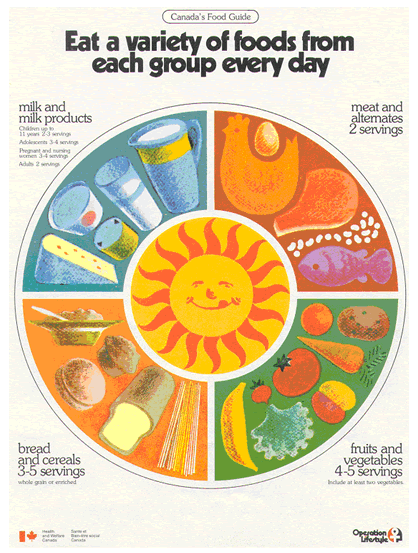

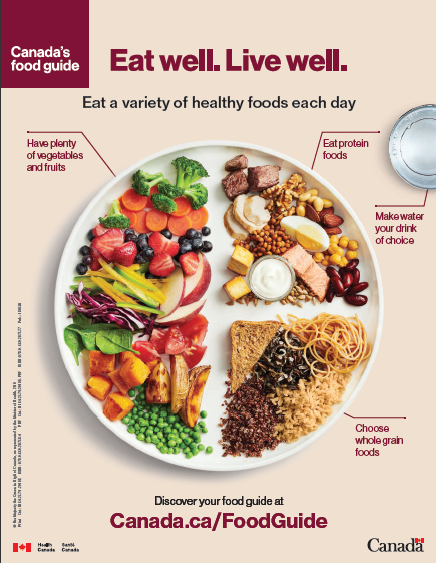

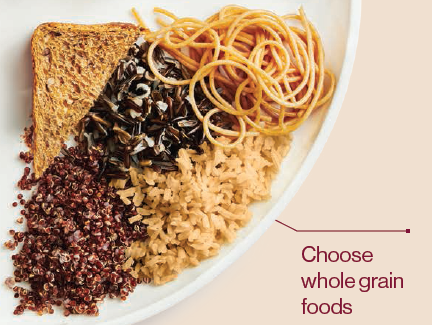
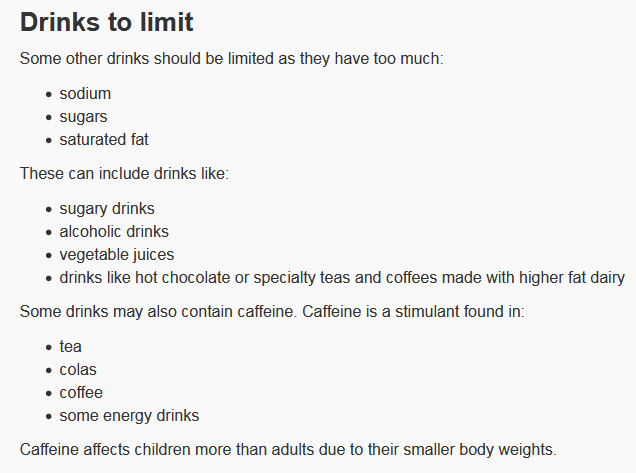

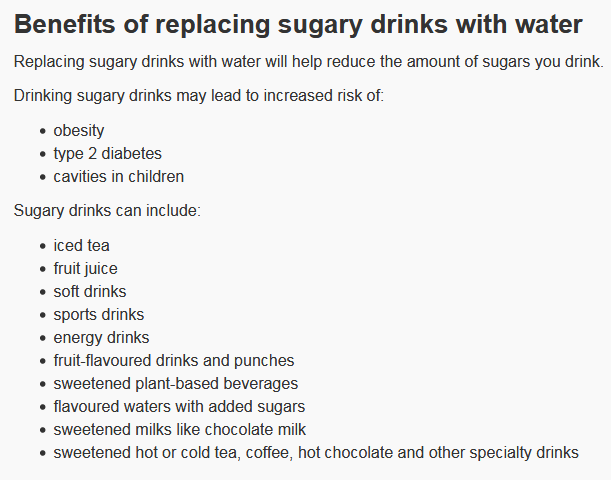
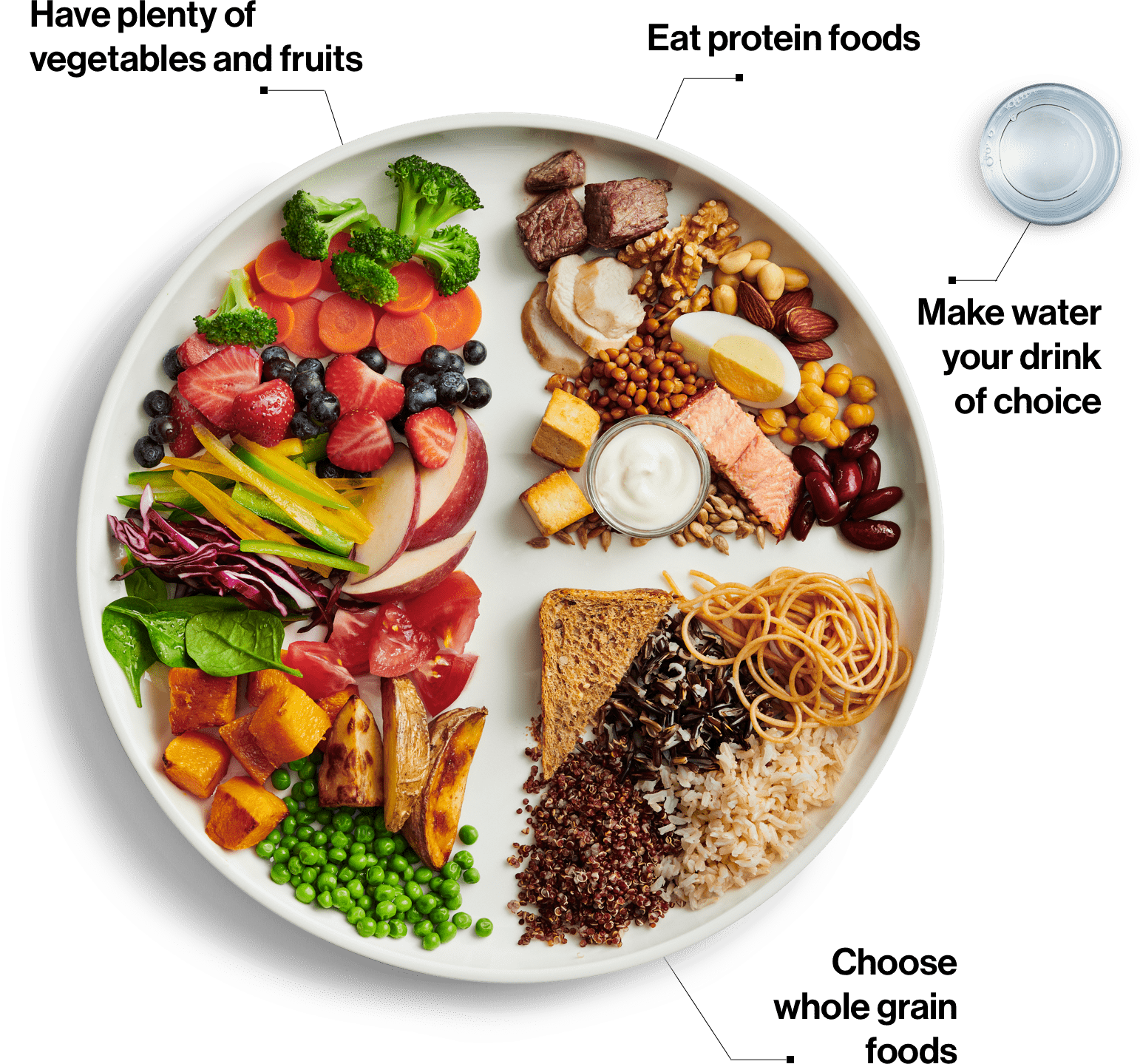

Good to see this focus on healthier eating. You can’t be happy and effective at what you do if you fuel your body with junk food. And almost everything in a typical grocery store is not healthy food.
None of us is likely to drink enough water. And many don’t have really great water to drink. I am very fortunate to have deep well water instead of chlorinated, fluoridated city water.
But even I don’t only drink water. For people who just can’t bear the thought of only drinking water, there are healthy alternatives.
I don’t drink caffeine or soda or fruit juice or anything else that comes in a jar, bottle or container. But I do drink many types of herbal tea.
And sometimes I sweeten it with Stevia. Until I get some Stevia plants growing, I do use the powdered type, but only the organic NOW brand Stevia. It doesn’t have the aftertaste others do. Many Stevia-like sweeteners contain artificial ingredients or are processed in unhealthy ways.
Do eat as much whole, fresh produce – both veggies and fruits – as possible. I only eat organic, but if you don’t have sources at least know which are safer. EWG.org provides lists of the most and least safe conventionally-grown produce to consume.
Busy people who don’t consume enough produce can find alternatives. My personal favorite is Organifi brand because it is organic and contains ingredients considered superfoods. I only found it recently, but drink their protein, red (fruit), green (veggies) and gold (turmeric and mushrooms in 3 flavors) every day. And have samples of some of their new products coming in the order that is on the way.
The gold is super low calorie and a healthy replacement for hot chocolate. It comes in plain, pumpkin (seasonally), and chocolate. I love the chocolate and pumpkin and plan to try the plain gold because it is the favorite of many who have tasted all the flavors.
Do what you can to get your family, friends and coworkers to eat healthy. Gifts of healthy foods (salmon, fruit, nuts, Organifi) are a good way to get them to try something new. And also a good way to help people who are in need financially, but too proud to accept assistance.